Written by Callum Madle.
COVID-19 has greatly impacted upon the income of freelance language services, especially translation and interpretation services. Between January and June 2020, those working in translation services saw their income decrease by 8% and those working in interpretation services saw their income decrease by 24%.
The significant decline in income for those working in interpreting services is primarily a result of the abrupt end to face-to-face events at which interpreters would find employment, such as conventions, conference centres, courtrooms and meetings.
To deal with the steep decline in their income, interpreters have had to adapt, using video conferencing on Zoom and Microsoft Teams, or interpreting via telecommunications. Now, with companies such as Microsoft, Spotify, Twitter and Facebook allowing employees the option to work from home, will services that operate as part of the new WFH (working from home) system, such as remote interpreting, continue to increase in demand?
What are the different types of interpreting?
Previous to the pandemic, the most popular type of interpreting was traditionally onsite interpreting. There are plenty of examples of on-site interpreting in action, for example at political conferences, translating in court or in the healthcare system. There are several distinctive types of onsite interpreting, those being simultaneous, consecutive and whispered interpreting:
- Simultaneous interpreting involves the interpreter relaying the speaker’s words in real time to the client in the same room, preserving the ease of flow of the speech of the speaker. This type of interpreting is used most prominently in business, but can also be used for instance during speeches or presentations.
- Consecutive interpreting is a back-and-forth process; the client speaks, after which the linguist translates their dialogue allowing the other party to process and respond to what they have said.
- Whispered interpreting involves the interpreter translating for one or two people, in which conservation might be spoke at a hushed tone. Unlike the aforementioned forms of interpreting, this service is provided to a much smaller number of people, usually for private meetings.
In contrast, as a result of the pandemic, most clients are seeking remote interpreting. Unlike on-site interpreting, neither the client or the interpreter are in the same location. Remote interpreting has been utilised in some of the same areas and industries as on-site interpreting, such as courtrooms, healthcare and the business sector. The main types of remote interpreting are Telephone Interpreting (OPI), Video Remote Interpreting (VRI), Remote Simultaneous Interpreting (RSI), and remote consecutive interpreting (RCI):
- Telephone Interpreting, or over the phone, is a service of interpreting delivered over the phone between a number of different parties, during which the interpreter communicates between the two parties via the telephone.
- Video Remote Interpreting is delivered through different video communication software, such as Microsoft Teams, Skype or Zoom. One benefit of this type of interpreting in comparison to telephone interpreting is that the linguist can pick up on helpful visual cues between the different clients.
- Remote Simultaneous Interpreting is also provided using video communication software or via telephone. It is usually provided at online events such as webinars, online conferences or panel-based discussions.
- Remote Consecutive interpreting is also provided via video conferencing software. It is used for online business meetings, interviews or negotiations.
Why is remote interpreting beneficial to customers?
The healthcare system is one of the markets with the highest demand for both on-site and remote interpreting. As a consequence of the precautions the healthcare system has had to take due to the widespread impact of the pandemic, such as the need for social distancing and PPE (protective personal equipment, on-site interpreting now raises a great deal of complications that have affected its effectiveness. There is still the possibility to continue some form of face-to-face interpretation when it is necessary and unavoidable, for instance in the context of end of life care.
However, remote interpreting is more beneficial to the healthcare system as well as for many other different employers in the long term, as it can be less expensive than face-to-face interpreting. For example, the use of video conferencing or telephone interpretation reduces the need for employers to cover the cost of travelling to and from one site to another.
Remote interpreting also makes it easier and more convenient for employers to get in contact with interpreters. Due to an increased ease of access of interpreters for a multitude of different languages, employers can simply contact interpreters via telephone or video conferencing software, and put them in contact with the person whom they need to translate or interpret. Although this ease of demand has meant that some employers can contact interpreters at very short notice, the convenience and flexibility of employing a remote interpreter highlights the advantage of remote interpreting to employers.
In Conclusion
It seems highly likely that some of the new workplace systems and ideas introduced during the pandemic, like working from home and the increased demand for remote interpreting, are here to stay for a long time. Considering that plenty of companies across a variety of different industries like Aviva (insurance), Utilita (energy company), and technology companies like Facebook and Twitter, have decided to allow their employees to work from home permanently, many face-to-face events may no longer be as prominent or necessary as was once the case.
Therefore, at Crystal Clear Translation, we have already adapted to the fluctuations that have occurred in the last year. We offer both telephone interpreting and remote interpreting services to our customers, as well as any other non-face-to-face interpreting and translation services.
If you should require translation or interpretation of any languages or dialect, you may be interested in the excellent services provided by Crystal Clear Translation. At CCT, we employ many efficient and reliable translators able to navigate the intricacies of many different languages and cultures. Click here for a quote if you should need interpretation or translation services in a multitude of different languages.


